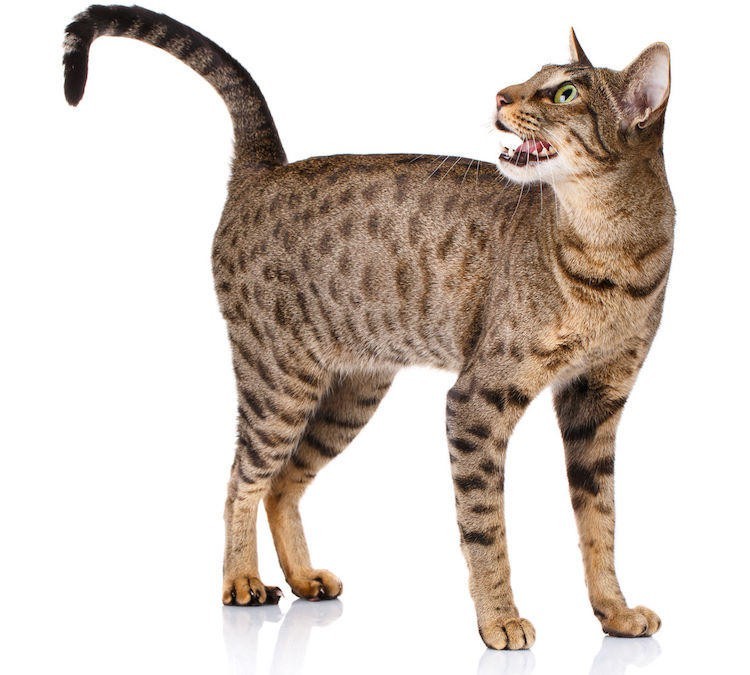
1. Key Characteristics
- Weight: 6–9 pounds for females, 9–14 pounds for males
- Life Expectancy: More than 15 years
The Ocicat is a medium-to-large spotted cat with a smooth and satiny coat.
The markings are well scattered around the body and the belly. This feline is muscular, graceful and resembles a wild cat.
Ocicats have large, almond-shaped eyes, moderately large ears and fairly long tails. Colors vary from brown and silver to blue and lavender.
The cool thing? Each hair contains more than one color.
2. Where They Came From
The Ocicat was created by crossing Siamese and Abyssinian cats, then later crossed with an American domestic shorthair cat.
The first known Ocicat was Tonga, owned by Virginia Daly of Michigan. She created and maintained the breed, which was registered in 1966 with the Cat Fanciers’ Association.
The breed earned championship status in 1987.
This was the first cat to be bred with the markings of a wild cat while keeping the disposition of a domesticated cat.

3. How Friendly Are They?
The Ocicat has a larger-than-life personality. These cats are outgoing and friendly — even to strangers — and will often welcome company.
They are not aggressive and are devoted to their humans. Playful, curious and highly intelligent, they can be trained.
They crave companionship and do not like to be alone for long periods of time.
Ocicats look at many things as toys, so it’s best to lock up anything you don’t want to go missing. Some Ocicats have been known to become possessive of their toys.
If they get bored too much or often, they can be mischievous — if you work long hours and don’t have any other pets, you might want to consider getting 2 Ocicats to keep each other company.
These cats have high energy levels and high intelligence, so they need physical exercise and mental challenges to keep them happy.
Because Ocicats are so friendly and outgoing, they travel well and adapt to new surroundings easily. They also do well with other cats and cat-friendly dogs. Keep a lookout when in the shower or tub, though — Ocicats are known to like water.
4. Is This the Right Cat for You?
Exercise Needs
Was YOUR Pet Food Recalled?
Check Now: Blue Buffalo • Science Diet • Purina • Wellness • 4health • Canine Carry Outs • Friskies • Taste of the Wild • See 200+ more brands…

LOW: Ocicats cats do not have any special exercise needs. Their physical activity should be similar to that of most cats (sleeping long hours, playing, running and jumping), although they are typically much more active and playful than other cats.
Contact your veterinarian if you notice a decrease in activity or mobility — this could be a sign of a health problem.
Grooming Needs
MEDIUM: The short coat of the Ocicat does not shed much, so you can brush it once per week.
You can bathe the cat as necessary, although this water-loving breed may happily jump in a running shower or bath. Some people use a chamois to dry their cats because it also adds shine to the coat.
Trim the cat’s nails as needed (usually once every 1–2 weeks), and clean the ears and teeth to promote good overall health.
Pay special attention to the ears. Ocicats have moderately large ears and can experience problems without proper grooming.
You’ll also need to brush their teeth regularly — they are prone to gingivitis.
Health Problems
LOW: Ocicats do not carry any known genetic or hereditary diseases or health problems.
They are prone to gingivitis, and neglecting this area could lead to future problems.
They are not prone to obesity, so you can free-feed them.
This video shows several examples of the Ocicat breed:

5. Where to Adopt One
If you consider getting an Ocicat, please check adoption resources — even purebred animals end up in shelters. Try Petful’s pet adoption center. (Select the “Cats” tab.)


